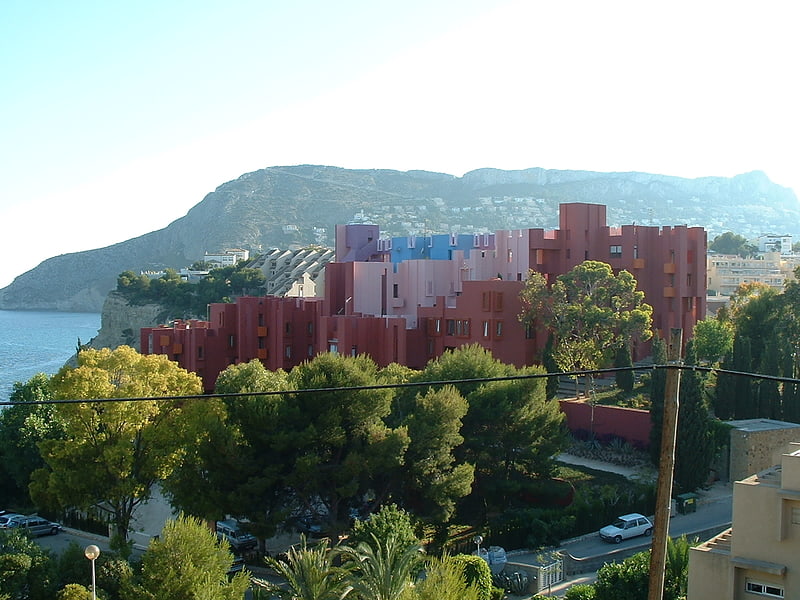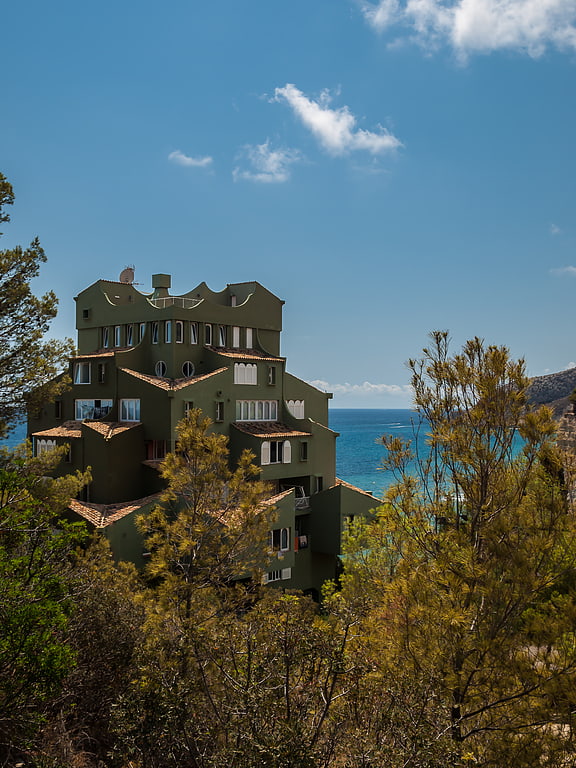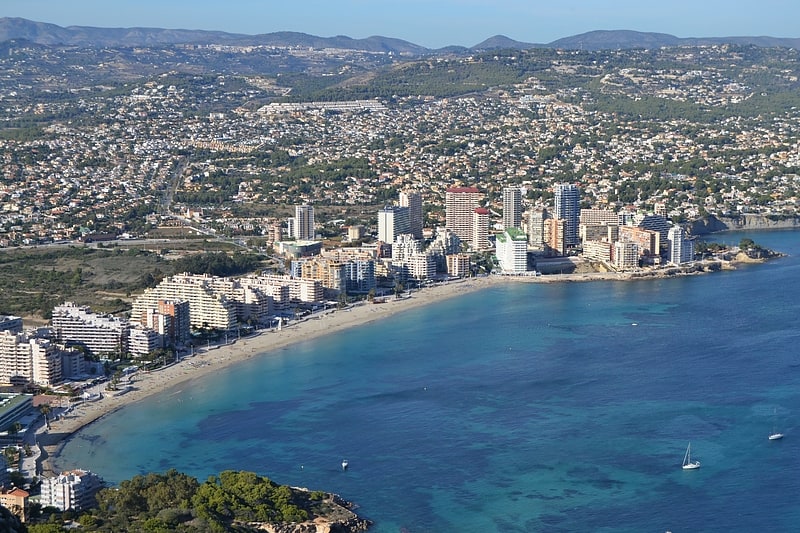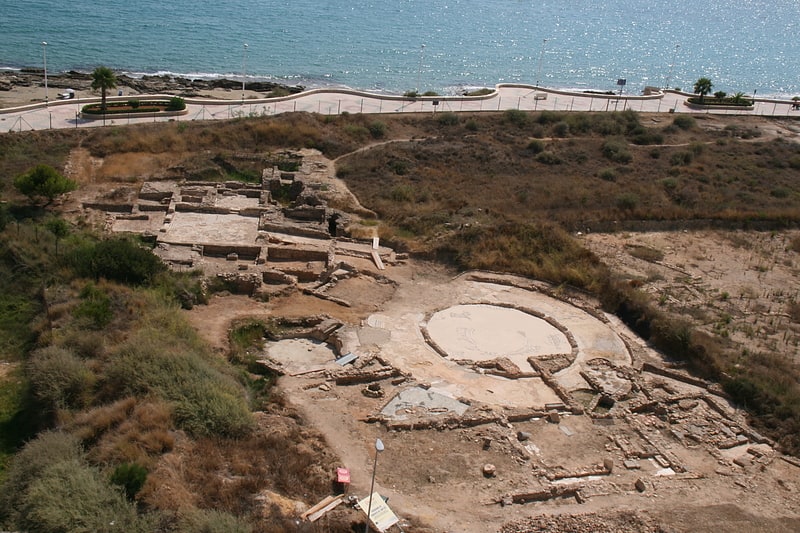Discover 7 hidden attractions, cool sights, and unusual things to do in Calpe (Spain). Don't miss out on these must-see attractions: La Muralla Roja, Xanadu, and Playa de Levante o La Fossa. Also, be sure to include Arenal-Bol in your itinerary.
Below, you can find the list of the most amazing places you should visit in Calpe (Valencia).
Table of Contents
La Muralla Roja

La Muralla Roja is a postmodern apartment complex in Manzanera, Calpe, Spain. It is designed by Spanish architect Ricardo Bofill for the client Palomar S.A. in 1968 and fully constructed by 1973. It has been ranked among "Ricardo Bofill's 10 Most Iconic Works".
In designing the building, Bofill referenced the architecture of North African casbahs and Arab Mediterranean architectural styles. It reinterprets the casbahs in an avant-garde fashion while incorporating the traditional elements like plazas (courtyards), staircases and bridges that connect all the apartments to one another.
As a residency, it holds several amenities such as two commercial stores, a sauna and a restaurant all on the first level. On roof terraces there are solariums and a swimming pool exclusively for use of its residents.
La Muralla Roja is referred to as a housing estate that has fifty apartments/ living spaces. There are three different styles and sizes of apartments: Studio apartments of approximately 60 square meters, two bedroom apartments of 80 square meters, and three bedroom apartments of approximately 120 square meters.[1]
Address: 3 Partida Manzanera, Calpe
Xanadu

Xanadu is an iconic complex of 17 apartments in Calp, Spain. It was designed by Ricardo Bofill Taller de Arquitectura and completed in 1968. It has been ranked among "Ricardo Bofill's 10 Most Iconic Works".
The building is intended to create "a garden city in space", with its vertical shape echoing the nearby Penyal d'Ifac rock formation. It was inspired by the Utopian practice of Archigram and its "plug-in city" concept of modular megastructures.[2]
Address: 2 Partida Manzanera, Calpe
Playa de Levante o La Fossa

La Fossa or Levante beach is a beach of sand, pebbles and rock in the municipality of Calpe, in the province of Alicante.
This beach is bordered to the north by the Calalga beach and to the south by the Peñón de Ifach and has a length of 950m, with a width of 40m.
It is located in an urban environment, having access by street. It has a promenade and parking delimited. It has access for the disabled. It is a marked beach that has a marked area for the exit of boats. It also has wooden access walkways, toilets and lifeguard post. The area closest to the rock is a very noisy area with discos and pubs, not recommended for families with children looking to relax.
This beach has been awarded the Blue Flag. It has no coastline
Address: Paseo Marítimo, 03710 Calpe
Arenal-Bol

Arenal-Bol beach is a sandy beach in the municipality of Calpe in the province of Alicante.
This beach is bordered to the north by Playa del Cantal Roig and to the south by La Manzanera and has a length of 1200 m, with a width of 40 m.
It is located in an urban environment, with street access. It has a promenade and delimited parking. It has access for the disabled. It is a marked beach that has a marked area for the exit of boats.
This beach is a Blue Flag beach.
Playa del Cantal Roig

Cantal Roig beach is a sandy beach in the municipality of Calpe, in the province of Alicante.
This beach is bordered to the north by the Port of Calpe and to the south by the Arenal-Bol beach and has a length of 200 m, with a width of 15 m.
It is located in an urban environment, with street access. It has delimited parking. It is a marked beach.
This beach is a Blue Flag beach.
Banys de la Reina

Los Baños de la Reina is an archaeological site located next to the salt pans of Calpe. It consisted of a Roman palace with a corridor, a courtyard and eight rooms. Its profusion of marble and mosaics reveal that it belonged to a person with high purchasing power. Among other elements, near the coastline there are artificial pools excavated in rock for fish farming and subsequent salting of fish, some baths, a waterwheel and four cisterns. Its 0.39 hectares also form a micro-reserve of flora. The house and its thermal building were built at the end of the 2nd or beginning of the 3rd century and abandoned at the beginning of the 5th century.
The structures were located in 1610 by Gaspar Juan Escolano and excavated on 18 and 19 May 1792 by Cavanilles. Their discovery was published in the Gazeta de Madrid. Their discovery was published in the Gazeta de Madrid. After the excavations in September 1965 by Manuel Pellicer Catalán and, above all, after the excavations (some of them salvage) carried out between 1993 and 1999, the ground plan of the complex has been determined, identifying it as a vicus of three houses whose economic orientation was the elaboration of wine, fishing, production of garum (fish sauce), salting and extraction of stone. Sepulchres have been found.
It is planned to sign an agreement between the Diputación de Alicante and Calpe to consolidate the archaeological remains with the collaboration of the MARQ.
Mercadillo Privado

Shopping, Market
Address: 6 Eslovenia, Calpe